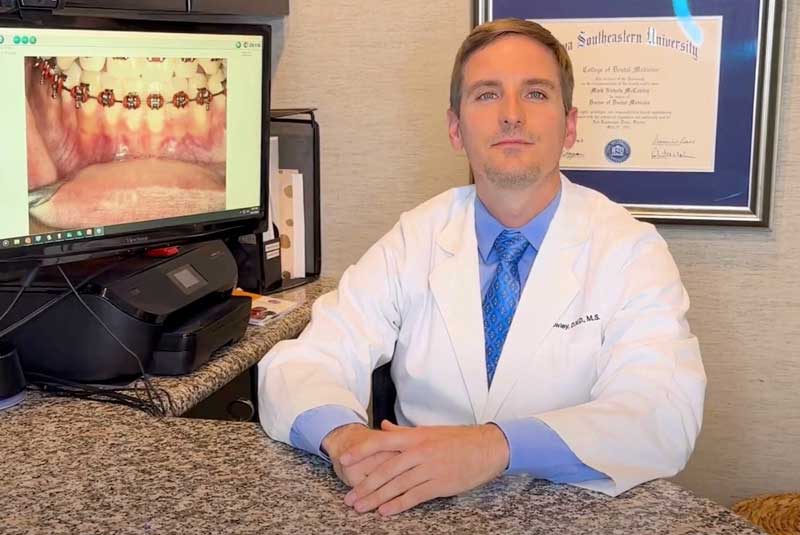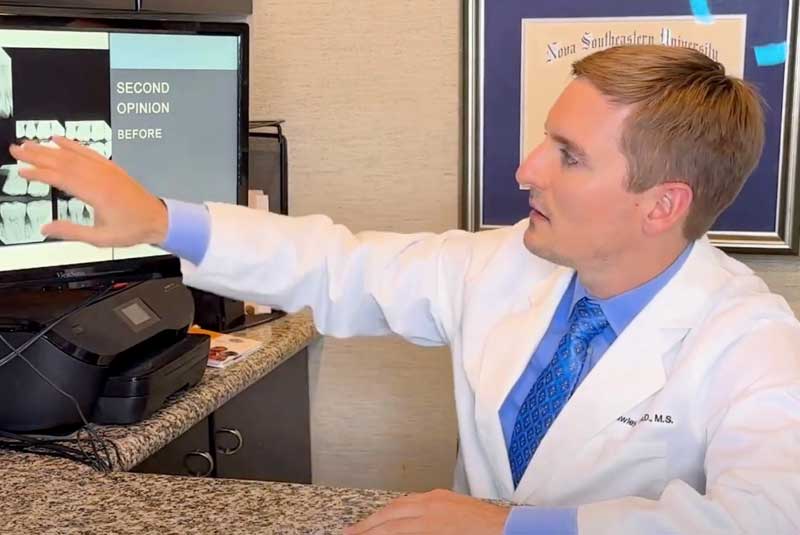Socket Preservation in Fort Lauderdale
When a tooth is removed, the body immediately begins a natural remodeling process. The empty socket that once held the root begins to collapse inward, and the surrounding bone starts to shrink.
This isn’t just a cosmetic issue, it can make it harder to place a dental implant later and may even change the shape of your face over time.
Socket preservation is a technique we use to prevent that. Without it, the area may lose volume and develop uneven contours or defects that can complicate future treatment or affect the appearance of your smile.
At McCawley Center For Laser Periodontics and Implants, we recommend this bone graft procedure when an implant isn’t being placed immediately. It helps preserve the socket and keeps the area healthy and stable until you’re ready for a dental implant.
We offer socket preservation bone grafting at our periodontal clinic in Fort Lauderdale, FL.
What Is Socket Preservation?
Socket preservation, also known as alveolar ridge preservation, is a preventive bone grafting procedure performed right after a tooth is removed. The goal is to preserve the shape and height of the alveolar bone, the part of the jaw bone that holds your teeth in place and provides essential support for dental implants and facial structure.
We place a small amount of bone graft material (also known as a bone substitute) into the empty socket, sometimes covering it with a membrane to encourage healing.
This helps prevent bone loss and encourages the body to build new, healthy bone in the area, while also supporting the surrounding facial tissues that contribute to your natural appearance. Over the next few months, your body naturally integrates the graft and builds new bone.
Learn more about dental bone grafts.
Why It Matters
If you are planning to replace a missing tooth with a dental implant, keeping the bone intact is essential.
Socket preservation helps maintain the bone density needed to support an implant and gives you time to consider your options. It also supports your long term oral health by preserving the natural foundation of your smile.
Even if you are not ready to decide on a tooth replacement right away, preserving the socket ensures that your choices remain open in the future.
How Long Can You Wait to Get a Dental Implant?
The timing of dental implant placement after socket preservation is important. While many patients move forward within four to six months, socket preservation also allows some flexibility.
That said, if an implant isn’t placed within a reasonable timeframe, the bone graft can begin to resorb, especially if left for a year or more without further treatment. This could lead to a loss in bone density or volume, which might require a second grafting procedure before an implant can be placed.
Socket Preservation Procedure Details
Socket preservation is a straightforward process performed immediately after a tooth is extracted. It focuses on protecting the empty tooth socket so that the bone and surrounding tissues can heal in a more predictable and stable way.
After the tooth is removed, the area is carefully cleaned to remove any debris. A special bone graft material is placed into the empty socket to help it keep its shape and support new bone growth.
Sometimes, a small artificial membrane is placed over the graft to protect the site and promote proper healing. This membrane helps stabilize the bone substitute and supports soft tissue regeneration.
As the area heals, your body gradually replaces the graft with its own natural bone. Most patients experience mild soreness for a few days, which can be managed with over the counter pain relief. It’s important to follow post operative instructions and attend follow up visits to ensure the graft heals properly and remains ready for future treatment.
Types of Bone Graft Materials
There are several types of bone graft materials that can be used during socket preservation. Each option will be discussed with you at your consultation:
Autograft: Bone taken from another part of your own body, such as the chin or hip. While effective, this option requires a second surgical site.
Allograft: Donor bone from a human tissue bank. This is a common option that eliminates the need for a second surgical site.
Xenograft: Bone derived from animal sources, typically bovine (cow). It is processed and sterilized to be safe and biocompatible.
Alloplast: Synthetic materials designed to support new bone growth. These can be made from calcium phosphate or similar substances.
Each type of graft material serves the same purpose, to help preserve the socket and promote new bone growth.
What Happens If You Do Nothing?
If no grafting is done after a tooth is removed, the body naturally begins to break down the bone that once supported it. The ridge may shrink or collapse, making it more difficult, more expensive, and more time consuming to place a dental implant in the future.
Taking action with socket preservation helps protect the site and keeps your options open. It also lowers the risk of jaw defects that can occur when bone loss becomes severe, making restorative treatment more complex. It also reduces the risk of unsightly defects in the gum and bone, which can make future restorative work more complicated or less aesthetically pleasing.
FAQs About Socket Preservation
Socket preservation is an investment in your long term dental health. Costs vary depending on the materials used, the complexity of the procedure, and where you are located. At our office a detailed examination is performed as well as a CBCT scan to provide the 3D volume of the site that requires grafting. After this our team will give you a detailed breakdown of the exact cost for your specific grafting needs.
Alveolar ridge preservation is simply another name for socket preservation. It’s a term that refers to maintaining the natural contour and volume of the bone after a tooth is removed. This is important for anyone considering a dental implant, since keeping the ridge intact reduces the chances of bone loss or additional grafting procedures later.
Socket preservation protects the bone and tissue immediately after a tooth is removed, making future dental implant placement easier, more predictable, and often less expensive. It gives you time to decide on the best replacement option without losing valuable bone structure.
Soft tissue healing typically occurs within two to three weeks after the procedure. However, full integration of the bone graft, where the material is gradually replaced by your natural bone, takes four to nine months depending on the size of the graft.
The procedure itself is typically performed under local anesthesia, so you should not feel pain while it’s being done. Afterward, most patients report only mild soreness, similar to what you would expect after a regular tooth extraction. Over the counter pain relievers are usually enough to manage any discomfort, and most people feel back to normal within a few days.
During the healing process, it’s possible for small fragments of bone to emerge through the gum tissue. These are called bone spicules. While they are usually harmless, they can be uncomfortable and may require a simple follow up to remove. Socket preservation helps minimize the chances of this happening. By filling the socket and guiding the bone to heal more evenly, we reduce the risk of sharp or uneven bone edges that could lead to spicules.
Schedule Your Consultation in Fort Lauderdale
If you are scheduled for a tooth extraction and want to protect your options for future treatment, socket preservation is a proactive step worth considering. By preserving the bone structure now, you make it easier, and often more affordable, to place a dental implant later.
To book an appointment with Dr. Mark McCawley at our periodontal office in Fort Lauderdale, FL, call (954) 807-4829 or visit us at 800 East Broward Blvd #706, Fort Lauderdale, FL.






